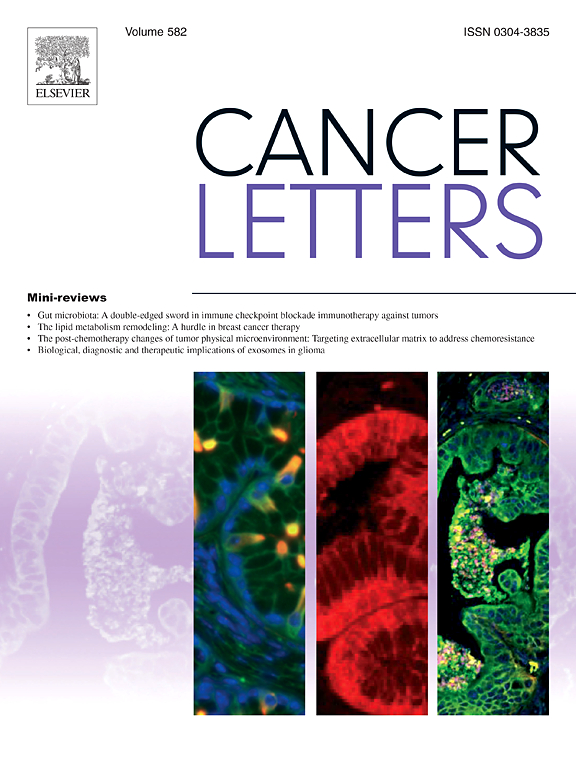CircSRPK1 mediated by the exon junction complex promotes gastric cancer progression by interacting with hnRNP A2B1 to regulate RON mRNA alternative splicing
IF 9.1
1区 医学
Q1 ONCOLOGY
引用次数: 0
Abstract
Gastric cancer (GC) is one of the most common malignant tumors with high heterogeneity, and its etiology and pathogenesis are unclear. Recently, many aberrantly alternatively spliced isoforms of the receptor tyrosine kinase recepteur d'origine nantais (RON) have been shown to play vital roles in GC development. Serine/arginine protein kinase 1 (SRPK1) is widely recognized as a key splicing factor kinase that regulates various steps of alternative splicing. Recent studies on SRPK1 have focused mainly on splicing activity, but the role of SRPK1-derived circular RNAs in RON alternative splicing and GC progression is unknown. Among all SRPK1-derived circRNAs in the CircInteractome, hsa_circ_0076168 (henceforth called circSRPK1) was upregulated in GC tissues compared with adjacent normal tissues, which was often associated with adverse outcomes in GC patients. Functionally, circSRPK1 promoted the malignant phenotype of GC. Mechanistically, circSRPK1 directly interacted with heterogeneous nuclear ribonucleoprotein A2B1 (hnRNP A2B1) to promote its nuclear translocation and binding to the exonic splicing enhancer (ESE) element on RON mRNA; this regulated the alternative splicing of downstream RON mRNA, induced RONΔ160 production, and ultimately promoted GC progression. More importantly, circSRPK1 production in GC cells was regulated by a component of the exon junction complex MAGOH, which enhanced the binding of EIF4A3 to the circSRPK1 transcript. Additionally, MAGOH knockdown rescued circSRPK1-mediated RONΔ160 formation and GC malignancy. Overall, our research revealed a novel mechanism by which the MAGOH–circSRPK1–hnRNPA2B1–RONΔ160 axis regulated GC cell proliferation and metastasis, broadening the current understanding of circRNA-mediated regulation of tumor progression through aberrant alternative splicing.
外显子连接复合体介导的CircSRPK1通过与hnRNP A2B1相互作用调控RON mRNA选择性剪接促进胃癌进展
胃癌(Gastric cancer, GC)是最常见的恶性肿瘤之一,异质性高,其病因和发病机制尚不清楚。最近,许多酪氨酸激酶原受体(RON)的异常选择性剪接异构体已被证明在GC的发展中起重要作用。丝氨酸/精氨酸蛋白激酶1 (SRPK1)被广泛认为是一个关键的剪接因子激酶,调节各种步骤的选择性剪接。最近对SRPK1的研究主要集中在剪接活性上,但SRPK1衍生的环状rna在RON选择性剪接和GC进展中的作用尚不清楚。在CircInteractome中所有srpk1衍生的circRNAs中,与邻近正常组织相比,hsa_circ_0076168(以下称为circSRPK1)在GC组织中表达上调,这通常与GC患者的不良预后相关。功能上,circSRPK1促进GC的恶性表型。在机制上,circSRPK1直接与异质核核糖核蛋白A2B1 (hnRNP A2B1)相互作用,促进其核易位并与RON mRNA上的外显子剪接增强子(ESE)元件结合;这调节了下游RON mRNA的选择性剪接,诱导RONΔ160的产生,最终促进了GC的进展。更重要的是,GC细胞中circSRPK1的产生受到外显子连接复合物MAGOH的一个组分的调节,这增强了EIF4A3与circSRPK1转录物的结合。此外,MAGOH敲除可挽救circsrpk1介导的RONΔ160形成和GC恶性肿瘤。总的来说,我们的研究揭示了MAGOH-circSRPK1-hnRNPA2B1-RONΔ160轴调节GC细胞增殖和转移的新机制,拓宽了目前对circrna介导的通过异常选择性剪接调节肿瘤进展的理解。
本文章由计算机程序翻译,如有差异,请以英文原文为准。
求助全文
约1分钟内获得全文
求助全文
来源期刊

Cancer letters
医学-肿瘤学
CiteScore
17.70
自引率
2.10%
发文量
427
审稿时长
15 days
期刊介绍:
Cancer Letters is a reputable international journal that serves as a platform for significant and original contributions in cancer research. The journal welcomes both full-length articles and Mini Reviews in the wide-ranging field of basic and translational oncology. Furthermore, it frequently presents Special Issues that shed light on current and topical areas in cancer research.
Cancer Letters is highly interested in various fundamental aspects that can cater to a diverse readership. These areas include the molecular genetics and cell biology of cancer, radiation biology, molecular pathology, hormones and cancer, viral oncology, metastasis, and chemoprevention. The journal actively focuses on experimental therapeutics, particularly the advancement of targeted therapies for personalized cancer medicine, such as metronomic chemotherapy.
By publishing groundbreaking research and promoting advancements in cancer treatments, Cancer Letters aims to actively contribute to the fight against cancer and the improvement of patient outcomes.
 求助内容:
求助内容: 应助结果提醒方式:
应助结果提醒方式:


